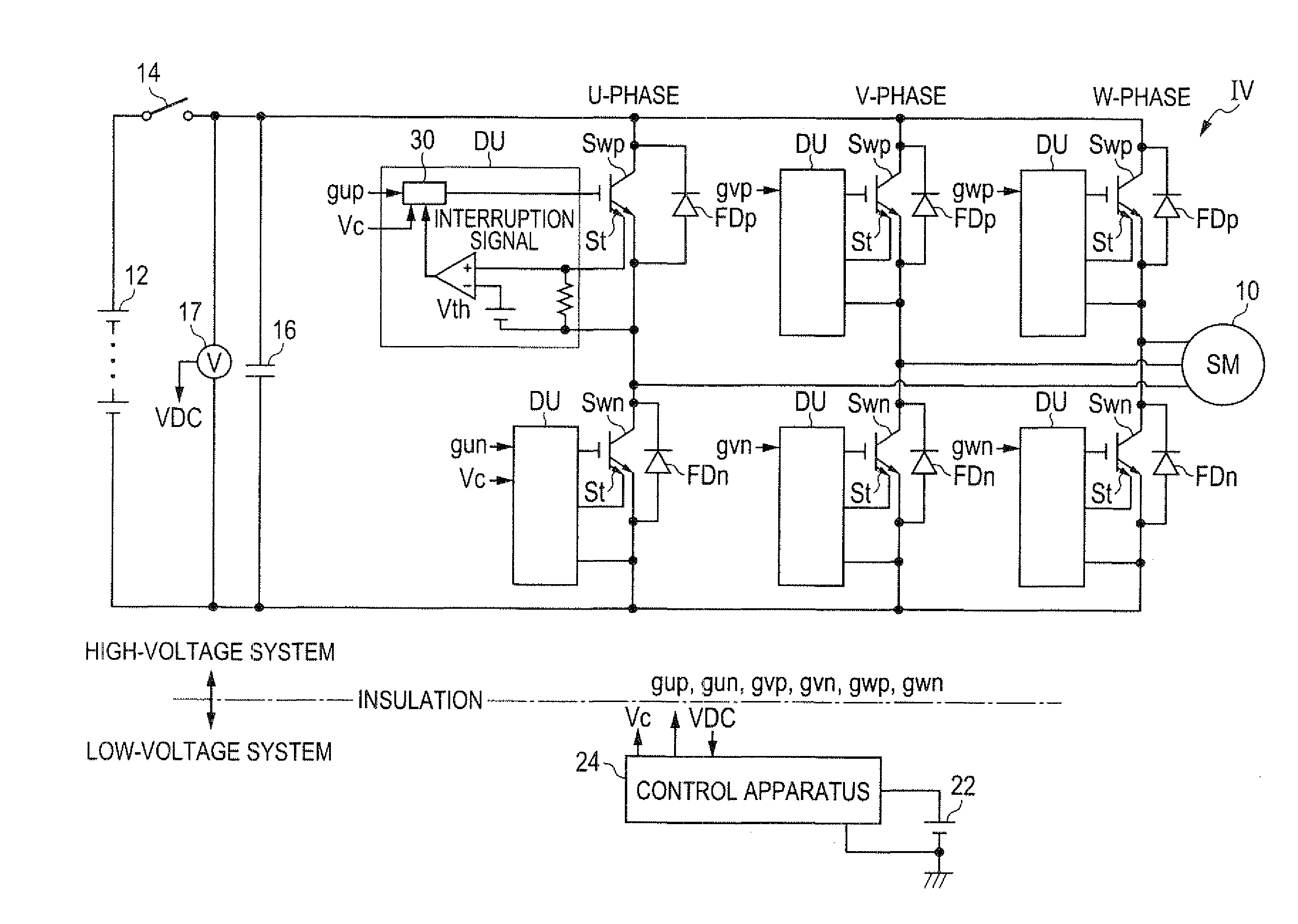Power conversion control apparatus
- Summary
- Abstract
- Description
- Claims
- Application Information
AI Technical Summary
Benefits of technology
Problems solved by technology
Method used
Image
Examples
first embodiment
[0031]FIG. 1 is a diagram showing the structure of a power conversion circuit for a hybrid vehicle including a power conversion control apparatus according to a first embodiment of the invention. As shown in FIG. 1, a motor-generator 10 as a vehicle main machine is connected to a high-voltage battery 12 and a capacitor 16 through an inverter IV and a main relay 14. The inverter IV is constituted of three parallel-connected pairs of series connections each including a high-side power switching element Swp and a low-side power switching element SWn. The connection node between the high-side power switching element Swp and the low-side power switching element Swn of each series connection is connected to a corresponding one of the respective phases of the motor-generator 10.
[0032]The input terminals (collector and emitter) of each of the high-side power switching elements Swp are respectively connected to the cathode and anode of a high-side freewheel diode FDp. The input terminals (co...
second embodiment
[0054]Next, a second embodiment of the invention is described with particular emphasis on the difference with the first embodiment.
[0055]FIG. 6 is a time chart explaining the discharge process performed in this embodiment. The sections (a) to (d) of FIG. 6 respectively correspond to the sections (a) to (d) of FIG. 3.
[0056]As shown in FIG. 6, in this embodiment, the low-side power switching element Swn of the U-phase is turned and off multiple times while the power switching element Swp of the U-phase is kept on during the period of the discharge process. Accordingly, a period in which both the high-side power switching element Swp and the low-side power switching element Swn are on occurs multiple times during one period of the discharge process. This makes it possible to prevent the high-side power switching element Swp and the low-side power switching element Swn from being overheated during the discharge process, because no current flows through the high-side power switching elem...
third embodiment
[0060]Next, a third embodiment of the invention is described with particular emphasis on the difference with the second embodiment.
[0061]FIG. 7 is a time chart explaining the discharge process performed in this embodiment. The sections (a) to (d) of FIG. 7 respectively correspond to the sections (a) to (d) of FIG. 3.
[0062]In this embodiment, the on time of the low-side power switching element Swn (the period of time during which the low-side power switching element Swn is on) is increased as the voltage of the capacitor 16 decreases. This is in view of the fact that the heat emitted from the power switching element Sw depends on the discharge energy of the capacitor 16, and the discharge energy is proportional to the product of the voltage and the current of the capacitor 16. The discharge energy decreases as the voltage of the capacitor 16 decreases. Hence, since the heat emitted from the power switching element Sw decreases as the voltage of the capacitor 16 decreases, the tempera...
PUM
 Login to View More
Login to View More Abstract
Description
Claims
Application Information
 Login to View More
Login to View More - R&D
- Intellectual Property
- Life Sciences
- Materials
- Tech Scout
- Unparalleled Data Quality
- Higher Quality Content
- 60% Fewer Hallucinations
Browse by: Latest US Patents, China's latest patents, Technical Efficacy Thesaurus, Application Domain, Technology Topic, Popular Technical Reports.
© 2025 PatSnap. All rights reserved.Legal|Privacy policy|Modern Slavery Act Transparency Statement|Sitemap|About US| Contact US: help@patsnap.com



